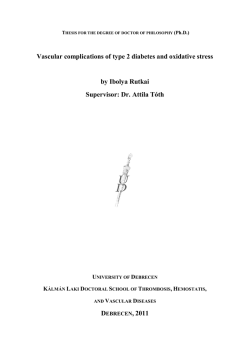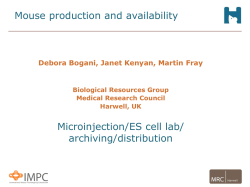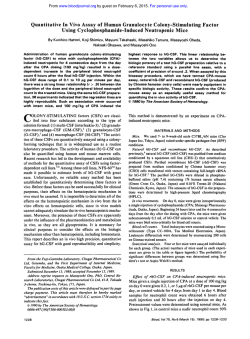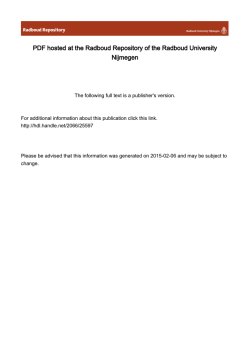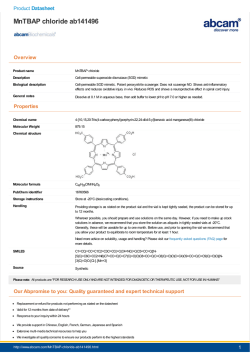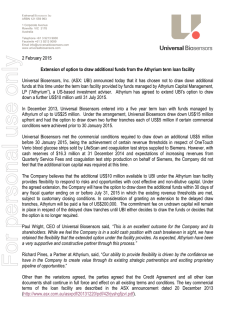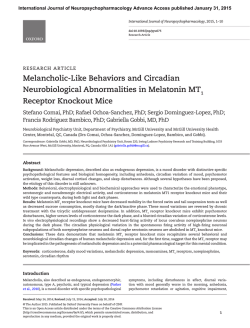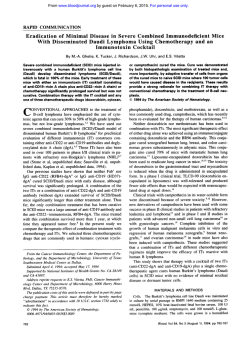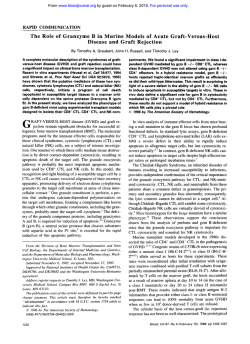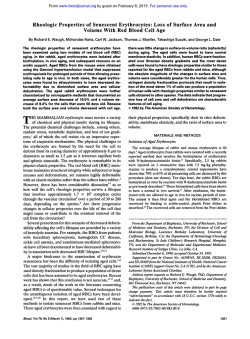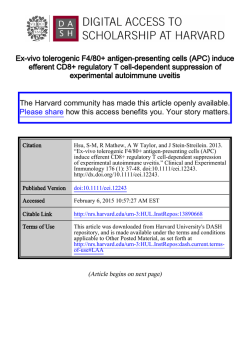
(Doll.) Ching - Journal of Chemical and Pharmaceutical Research
Available online www.jocpr.com Journal of Chemical and Pharmaceutical Research, 2015, 7(1):386-389 Research Article ISSN : 0975-7384 CODEN(USA) : JCPRC5 Anti-aging activities of polysaccharides from Athyrium multidentatum (Doll.) Ching Dongmei Liu, Jiwen Sheng, Huimin Qi* and Weifen Zhang Department of Pharmacy, Weifang Medical University, Weifang, PR China _____________________________________________________________________________________________ ABSTRACT In this paper, the anti-aging effect of polysaccharides extracted from Athyrium multidentatum (Doll.) Ching (PA) was investigated on aged mice induced by D-galactose. After administration of PA for 40 days, SOD, CAT and GSH-Px activities in PA groups was significantly enhanced and MDA level was decreased compared with aged group. There were significant differences between PA high dosage group and aged group (P < 0.05). SOD activity in PA high dosage group was 123.7 ± 12.5 U/mL, which was stronger than VE group and similar to normal group. The antioxidative enzyme activities in mice were increased in dose-dependent patterns. These results demonstrated that PA could remarkably augment the activities of antioxidative enzymes and lessen the product of lipid peroxide, which might provide an explicit interpretation to the anti-aging mechanism of PA. Key words: Athyrium multidentatum (Doll.) Ching, Anti-aging, Polysaccharides, D-galactose. _____________________________________________________________________________________________ INTRODUCTION Everyone has a dream of enjoying the youth and health for ever. However, aging will arrive sooner or later, irresistibly. Aging, a complicated process of biology, can be described as the accumulation of diverse deleterious changes occurring in cells and tissues with advancing age that are responsible for the increased risk of disease and death [1]. Researchers from all over the word are endeavouring to disclose the mechanism of senescence and decelerate the befalling of aging. So far, there are several theories concerning aging such as immune theory, nerve-endocrine theory and heredity theory. Among these theories, the free radical theory is generally acknowledged and has been certified by numerous experiments. This theory states that free radicals, especially oxygen-derived free radicals such as •O2−, •OH and H2O2, are responsible for the damage of biomolecules resulting in changes to the biology of the cell and thus organismal aging [2]. Antioxidants may postpone aging by reacting directly with free radicals, or by enhancing the activity or expression of antioxidant enzymes, such as superoxide dismutase (SOD), catalase (CAT), and glutathione peroxidase (GSH-Px) [3]. D-galactose, a simple monosaccharide that contains six carbons and an aldehyde group, can induce oxidative stress in non-cancer cells and result in cell damage by disturbing glucose metabolism [4]. Therefore, mice treated with D-galactose are usually used as model animals for the study of oxidative stress. Athyrium multidentatum (Doll.) Ching (AMC), an edible medicinal fern native to Changbai Mountain area of China, is recognized as an unparalleled resource of healthy foods and drug discovery. Our previous studies found that polysaccharides from AMC possessed strong scavenging capacities towards superoxide anion and hydroxy radicals [5-7]. According the free radical theory of aging, antioxidants can retard the process of aging by preventing free radicals from oxidizing sensitive biological molecules or reducing the formation of free radicals. Polysaccharides from AMC were effective antioxidant and might be potential anti-aging agent. Nevertheless, to our knowledge, there is no reports on anti-aging effect of polysaccharides from AMC. In this study, the anti-aging activity of polysaccharides from AMC was investigated by aging mice model induced by 386 Huimin Qi et al J. Chem. Pharm. Res., 2015, 7(1):386-389 ______________________________________________________________________________ D-galactose. Mechanisms on the anti-aging actions of the polysaccharides were discussed preliminarily. EXPERIMENTAL SECTION Materials: The rhizome of Athyrium multidentatum (Doll.) Ching was obtained from Changbai Mountain area of China, and deposited at the pharmaceutical laboratory of Weifang Medical University. D-galactose and vitamin E (VE) were purchased from Sigma Chemical Co. (St. Louis, MO, USA). The detection kits for antioxidative enzymes (SOD, CAT and GSH-Px), malondialdehyde (MDA), and protein were purchased from Nanjing Jiancheng Bioengineering Institute (Nanjing, PR China). Preparation of polysaccharides: 1 kg of crushed AMC rhizome was soaked in methanol at room temperature for a month. The resultant residues were refluxed in 8000 mL distilled water for 3 h and filtered thermally. The hot solution was collected and concentrated to about 100 mL under reduced pressure, then precipitated with anhydrous ethanol. The resultant precipitate was washed with anhydrous ethanol three times and dried at room temperature. Polysaccharides extracted from AMC rhizome (PA) was acquired (mean yield 7.2%). Animals and experimental protocol: Male and female Kun Ming mice weighing 48−52 g were provided by Experimental Animal Center of Shandong Province, Jinan, China. The animals were group-housed in a controlled environment (25 ± 1℃, humidity 60 ± 5%) with a photoperiod of 12 h light and 12 h dark cycle. All mice were fed ad libitum and conditioned in a non-stressful environment. All experimental procedures executed in this study were approved by the ethics committee of Weifang Medical University. After one week of adaption, the animals were randomly divided into a normal group, an aged group, a positive control group (VE), three PA groups. Except for the normal group, other five groups were treated with D-galactose at 100 mg/kg·d by intraperitoneal injection. 16 days later, freshly prepared VE (25 mg/kg) and PA (20, 40, and 60 mg/kg) were orally administered once a day for 40 consecutive days. The normal and aged groups were treated with normal saline, respectively. The animals were weighed weekly to adjust the dosage. The experiments were carried out totally for 8 weeks. Preparation of tissues: At the end of treatment, the animals were anesthetized with diethyl ether and blood samples were collected by extracting eyeballs from the mice. Then the animals were executed by cervical vertebra disjointing and the livers were immediately extracted. The serum sample was obtained from the blood centrifuged at 3000 r/min for 10 min at 4℃. The livers were grinded in normal saline, and centrifuged at 3000 r/min for 10 min at 4℃, then the supernatants were respectively collected and stored at −20℃ for CAT, GSH-Px, MDA and protein assays. Biochemical analysis: All biochemical indexes were detected according to the standard assay kit (Nanjing Jiancheng Bioengineering Institute, Nanjing, China). SOD activity was measured by xanthine oxidase method. The activity of CAT was assayed by measuring the absorbance of H2O2 at 240 nm. GSH-Px activity was determined by quantifying the catalysed reaction rate of H2O2 and GSH at 420 nm, spectrophotometrically. Lipid peroxide was tested by measuring MDA content at 532 nm. The protein concentration was determined by Coomassie brilliant blue method described as the protein quantitative test kit. Statistical analysis: The data are expressed as mean ± SD. Dunnett’s t-test was used to compare the differences between the treated groups and aged groups, and differences were considered significant at p < 0.05. RESULTS AND DISCUSSION Effect of PA on SOD activity in serum of mice. SOD activity in serum of mice was displayed in table 1. As shown in table 1, SOD activity in groups treated with D-galactose was weakened compared with normal group. After administration of PA, the activity of SOD in serum of the aged mice increased in a dose-dependent manner. The SOD activity in PA high dosage group was significantly enhanced vs aged group (P < 0.05), and was stronger than VE group. In normal group, SOD activity in serum of mice was 124.1 ± 1.6 U/mL, which was similar with PA high dosage group. These results implied that PA could resist the attenuation of SOD activity induced by D-galacose. SOD is an important antioxidant defense enzyme and plays an important role in keeping the balance of antioxidative system. It protects the cells against damage by catalyze the dismutation or partitioning of the toxic superoxide radical into oxygen or hydrogen peroxide, then the latter was whereafter degraded by catalase. Thus, the improvement of SOD activity would be beneficial to the organisms or cells for protecting against diseases that initiated by surplus of superoxide radical or decreased SOD activity. Yuan et al. reported that total flavonoids from Epimedium could protect male mice against testicular reproductive toxicity by up-regulating the expression of antioxidant enzymes, especially SOD3 and GPX1 [8]. Cordyceps sinensis extract exhibited anti-aging effects by improving the activity of superoxide dismutase, glutathione peroxidase and catalase and lowering the level of lipid peroxide and monoamine oxidase activity in mice with D-galactose-induced senescence [9]. Likewise, PA showed 387 Huimin Qi et al J. Chem. Pharm. Res., 2015, 7(1):386-389 ______________________________________________________________________________ the anti-aging effects by increasing the activities of antioxidative enzymes and decreasing the level of lipid peroxide, which has been observed in this assay. Table 1 SOD activity in serum of mice. Values are means ± S.D. (n = 10) Dosage SOD activity (mg/kg/d) (U/mL) normal − 124.1±1.6 aged 100 108.4±7.7 VE 25 119.7±12.4 20 110.2±11.3 40 115.6±16.8 PA 60 123.7±12.5* Note: compared with aged group,* P < 0.05 Group Effect of PA on CAT and GSH-Px activities and MDA level in liver of mice. The effects of PA on CAT/GSH-Px activities and MDA level in liver of mice were investigated and summarized in table 2. In this assay, one active unit is defined as a 1 µmol/L of abatement for the GSH concentration in per mg protein of a reaction system after deducting the effect of non-ezyme reaction per minute. In PA groups, CAT and GSH-Px activities were significantly augmented, and MDA level was decreased compared with aged group (Table 2). There was notable difference in the activities of CAT/GSH-Px and level of MDA between PA high dosage group and aged group (P < 0.05). The CAT and GSH-Px activities in PA groups were in dose-dependent patterns. However, MDA level in PA groups exhibited in a non-dose-dependent manner. GSH-Px activity in PA high dosage group was weaker than VE and normal groups, but stronger than aged group. Moreover, CAT activity in PA high dosage group was higher than VE and normal groups. These results suggested that PA could remarkably enhance the activity of CAT in liver of mice. Catalase, a enzyme which distributes widely in nearly all living organisms, can protect the cell against oxidative damage by catalyzing the decomposition of H2O2 to H2O and O2 [10]. Hence, CAT can be used in the food industry, food wrappers or textile industry for removing hydrogen peroxide or preventing food from oxidizing. GSH-Px, one of the glutathione-depleting enzymes, is a more efficient metabolizer of H2O2 than CAT. MDA, a major product of lipid peroxide, is regarded as an index of antioxidant protection and a marker of aging [11]. MDA can bond with free amino groups and result in atherosclerosis, DNA damage, mutation, and other diseases related with aging [12, 13]. At a dose of 400 mg/kg·d, polysaccharides from Cordyceps taii could significantly enhance the activities of superoxide dismutase, catalase, and glutathione peroxidase, and markedly decrease the level of malondialdehyde in aging mice induced by D-galactose [14]. These findings proposed that the anti-aging capacity of PA might be related with their abilities of increasing the activities of antioxidative enzymes and decreasing the product of lipid peroxide. Table 2 CAT/GSH-Px activities and MDA level in liver of mice. Values are means ± S.D. (n = 10) Dosage CAT activity GSH-Px activity MDA content (mg/kg/d) (U/gHb) (active unit) (nmol/mgprot) normal − 268.2±3.2 929.5±16.9 1.93±1.48 aged 100 223.8±22.9 611.7±20.8 2.82±1.31 VE 25 237.1±21.2 857.8±12.4** 2.09±1.16* 20 253.7±20.4 569.3±19.8 2.23±0.78 PA 40 283.2±13.4 632.9±18.3 2.66±0.51 60 291.9±16.1* 703.8±20.7* 2.21±0.32* Note: compared with aged group,* P < 0.05,**P < 0.01 Group CONCLUSION In conclusion, polysaccharides extracted from Athyrium multidentatum (Doll.) Ching (PA) rhizome could ameliorate SOD, GSH-Px and CAT activities, and lessen MDA level in aged mice induced by D-galactose. Furthermore, PA could scavenge the free radicals, directly [14]. All results suggested that polysaccharides from Athyrium multidentatum (Doll.) Ching possessed prominent antioxidant and anti-aging properties, and could be a promising adjuvant agent for preventing aging. Acknowledgements This study was supported by the Natural Science Foundation of Shandong province (ZR2013HQ024/ ZR2012CM025), the Scientific and Technological Innovation Foundation of Weifang Medical University (K1302004), and National Key Technology R&D Program of the Ministry of Science and Technology (2013GA740103). 388 Huimin Qi et al J. Chem. Pharm. Res., 2015, 7(1):386-389 ______________________________________________________________________________ REFERENCES [1] D Harman, Biogerontol., 2009, 10(6), 773-781. [2] I Afanas'ev, Aging Dis., 2010, 1(2), 75-88. [3] JM Lü; PH Lin; QZ Yao; CY Chen, J. Cell. Mol. Med., 2010, 14(4), 840-860. [4] N Li; Y He; L Wang; C Mo; J Zhang; W Zhang; J Li; Z Liao; X Tang; H Xiao, J. Cell Biochem., 2011, 112(12), 3834-44. [5] DM Liu; JW Sheng; ZJ Li; HM Qi; YL Sun; Y Duan; WF Zhang, Int. J. Biol. Macromol., 2013, 56, 1-5. [6] DM Liu; JW Sheng; HM Qi; WF Zhang; CM Han; XL Xin, J. Med. Plants Res., 2011, 5(14), 3061-3066. [7] JW Sheng, J. Chem. Pharm. Res., 2014, 6(6), 1129-1135. [8] D Yuan; HW Wang; HB He; LL Jia; YM He; T Wang; X Zeng; YZ Li; SC Li; CC Zhang, Phytother. Res., 2014, 28, 88-97. [9] DB Ji; J Ye; CL Li; YH Wang; J Zhao; SQ Cai, Phytother. Res., 2009, 23, 116-122. [10] P Chelikani; I Fita; PC Loewen, Cell. Mol. Life Sci., 2004, 61(2), 192-208. [11] P Gil; F Fariñas; A Casado; E López-Fernández, Gerontology, 2002, 48(4), 209-214. [12] R Stocker; JF Keaney, Physiological Reviews, 2004, 84(4), 1381-1478. [13] LJ Niedernhofer; JS Daniels; CA Rouzer; RE Greene; LJ Marnett, J. Biol. Chem., 2003, 278(33), 31426-31433. [14] JH Xiao; DM Xiao; DX Chen; Y Xiao; ZQ Liang; JJ Zhong, Evid Based Complement Alternat Med., 2012, 273435. 389
© Copyright 2026



